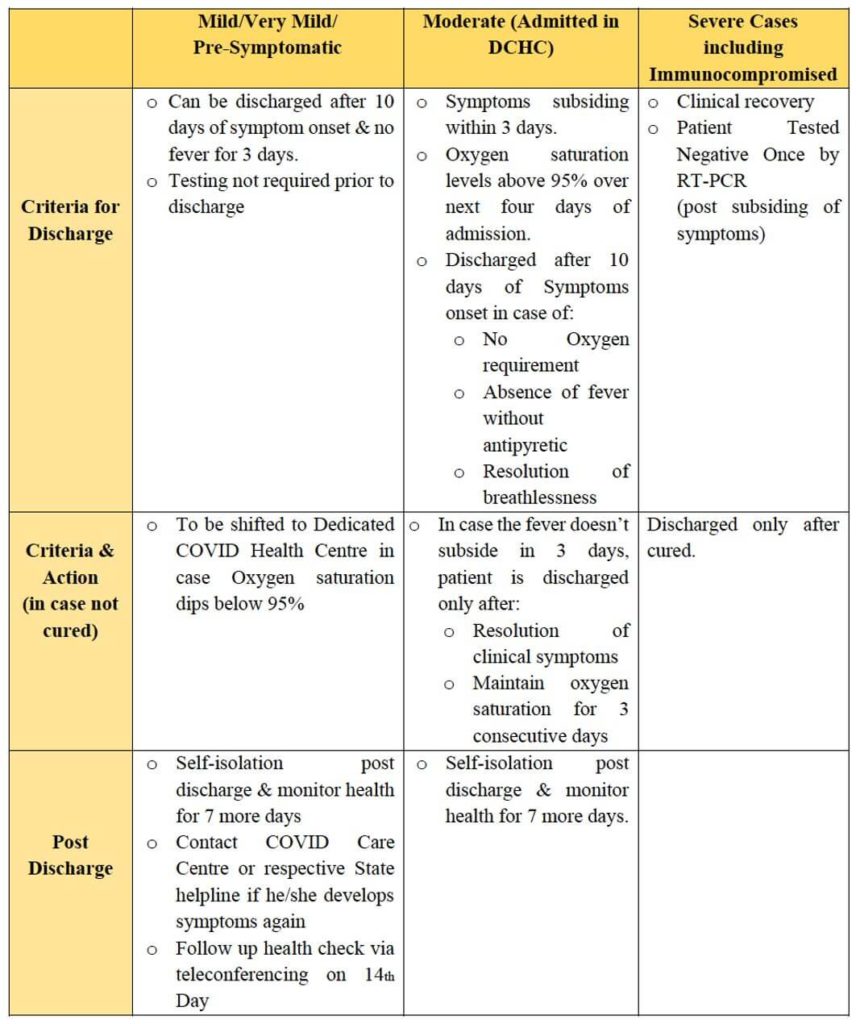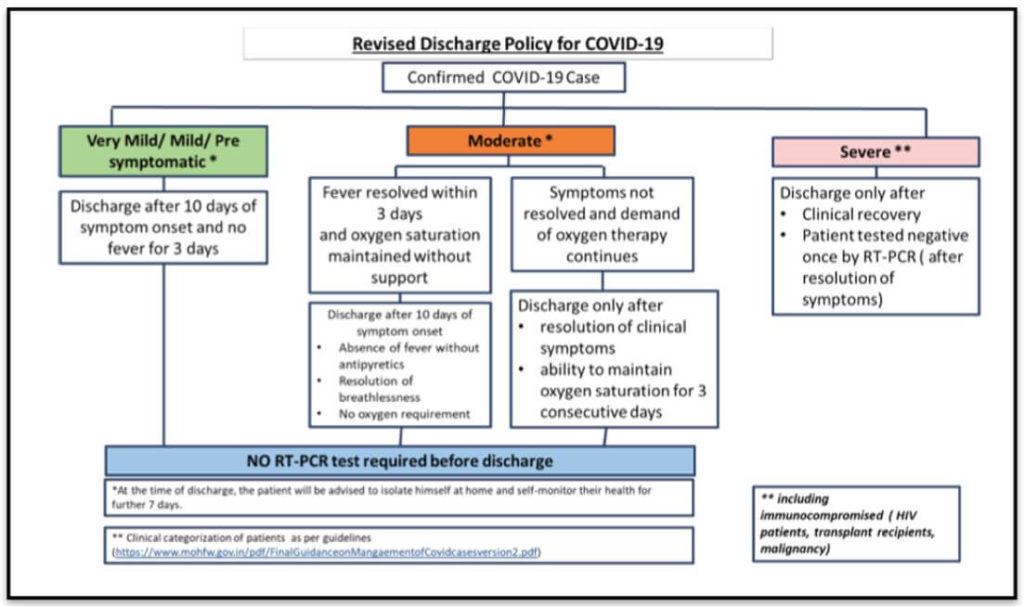The government modified the discharge policy of COVID-19 positives and issued revised guidelines recently. Here is a look at those guidelines and discharge guidelines in a few other countries.
Post treatment discharge of COVID-19 infected patients is as important as identification of the infected ones. An effective discharge policy ensures that the infected persons are treated well and also helps in mitigating any scope of re-admission and further spread. Hence it is important that the discharge policy & the relevant strategies are comprehensive enough to cover all types of patients. The policies should also facilitate determination of the time when it is safe to discharge a particular case. Discharge of the treated & recovered patients also reduces the burden on the healthcare system freeing up the available beds for other needy ones.
The Ministry of Health and Family Welfare (MoHFW) issued a revised discharge policy for COVID-19 cases on 11 May 2020. This policy replaces MOHFW’s earlier discharge policy.

Revised policy marks a shift from ‘Test-based’ discharge strategy
As per the press release on the revised discharge policy, the Health Ministry has stated that the policy was revised in line with revisions in several other countries who have changed their discharge criteria.

The earlier policy for discharging COVID-19 patients was based on a test-based strategy. As per this policy, a COVID-19 case was discharged when the person satisfies each of the following two criteria:
- Clearing a Chest Radiograph
- Two consecutive negative test results on RT-PCR (Reverse transcription polymerase chain reaction) within 24 hours

Most of the countries have changed discharge policy from a ‘Test Based’ strategy to ‘Symptom Based’ or ‘Time Based one’, as mentioned by the MoHFW. In the FAQs released by MoHFW about the revised policy, it is stated that a review of ICMR laboratory surveillance data indicates that after an initial RT-PCR positive results, the patients became negative after a median duration of about 10 days.
Speaking on the revised Discharge policy, experts at ICMR stated that as per studies, the virus is said to be deactivated in case the patient does not show symptoms for three days. It is also highlighted in the reasons backing up the revised discharge policy that there are chances where tests can detect the virus even after it becomes in-active.

Based on this, a revised discharge criterion is implemented which will do away with the need for conducting the tests before discharge. This would also help in saving valuable test kits, which could then be used for other identification of COVID-19 in suspects.
Revised discharge policy aligned with severity-based categorization of cases
The revised discharge policy uses ‘Time’ and ‘Symptoms’ as the criteria instead of testing to determine if particular COVID-19 case can be discharged. However, the time taken to recover from the infection and the symptoms vary depending on the severity of the infection. Hence the revised discharge policy provides for different criteria for different cases of severity.
MoHFW had earlier issued guidelines to categorize the COVID-19 cases based on the clinical severity into – mild, moderate & severe. The revised discharge policy is also based on this categorization.
The time frames to discharge and the symptoms to be looked for each of these three categories of patients have been specified.

Post discharge, the patients (those with mild and moderate severity) are required to be under self-isolation for period of 7 days. During this period, they are required to ensure:
- Use of triple layer medical mask all the time
- Stay in identified space and away from other people at home
- Need to be especially away from those with co-morbid conditions – hypertension, cardiovascular diseases, renal diseases etc.
- Maintain strict personal hygiene
- Self-monitoring – monitoring the temperature, report in case of any deterioration of symptom.

No testing needed for Home isolation patients as well
Cases with clinical severity of mild/very mild or which are pre-symptomatic are also provided the option of being under home isolation right from the beginning without having to get admitted to a COVID facility. However, this is possible only if the facilities at home are in line with the specified criteria. Factly has written a story on these conditions and other criteria.
As per the revised discharge policy, even such patients under home isolation are not required to take any tests prior to being declared discharged (cured). The criteria remain the same as in the case of patients in COVID Care centres i.e. 10 days post the onset of symptoms & no fever for 3 days. They are also required to self-monitor further for a period for 7 days i.e. the criteria for home isolation would be:
- 17 days of home isolation (10 + 7 days) after onset of symptoms
- No fever for 10 days (3 + 7 days)
For those who are under self-quarantine because of exposure to COVID-19 positive patients but are asymptomatic, the discharge policy does not apply. They continue to be in quarantine for a period of 14 day.
The approach of dealing with COVID-19 cases has varied across countries. This is also true in the case of discharge policies. There is still a debate whether testing needs to be carried out to discharge COVID-19 patients. However, following a time-bound and symptomatic approach based on the studies and observations conducted so far seems like a better approach.
There are reports that point out to an increase in the recovery rate in India post the revised discharged policy. However, it would be early to draw any conclusion if the revised strategy is a better approach.
There are some important insights from the discharge policies of other countries. Here is a look at few of them.
South Korea: South Korea has one of the highest recovery rates across the globe. The aggressive approach followed by South Korea in tracing the COVID-19 patients and testing them for infection has been lauded and is attributed to be one of the reasons for containing the spread. Their approach in early detection of cases has also been seen as a reason for higher recovery rates.
In case of moderate and high-risk clinical severity, the infected patients are admitted into medical facilities for treatment of the symptoms. Such patients who recover are required to be tested negative twice to be discharged.
In case of mild and pre-symptomatic cases, the patients are required to be in self quarantine for a period of 14 days. There have been reports of patients testing positive for COVID-19 after being recovered and discharged, however some latest studies indicate that such patients are not infectious.
European Union: The EU has laid out an advisory for its member countries regarding discharge criteria for COVID-19 patients.
- Factors such as existing capacity of health care system, laboratory diagnostic resources and the current situation of the epidemic ought be taken into consideration
- In case there is no pressure on health care system and optimal testing capacity
- Clinical criteria – no fever for three days, improved respiratory symptoms, no hospital care needed.
- 2-4 negative RT-PCR tests. Testing to be conducted 7 days after the first RT-PCR test.
- Results from Serology test if available.
- In case there is widespread epidemic resulting in pressure on health care and resting systems.
- Discharge of mild patients after testing for clinical symptoms. 14 days of further isolation after discharge. (provided the patient’s home is suited for isolation)
- Careful personal hygiene and protection warranted post de-isolation.
United States: Centre for Disease Control (CDC) and Prevention has provided the discharge guidelines, for symptomatic and non-hospitalized patients. It has recommended for Test based strategy, time based as well as symptom-based strategies to be followed, which the medical practitioner needs to review and take a call on a case by case basis.
- Negative RT-PCR results for at least 2 consecutive two test swabs (nasopharyngeal & throat). There needs to be a difference of 24 hours between them.
- Reduction of fever without using antipyretic medication
- Improvement in symptoms
- 10 days since COVID-19 positive test
- Isolation to be followed with the specified guidelines.
Featured Image: COVID-19 discharge policy


